A PR representative provided Play Critically with a review code for this videogame.
Momodora: Moonlit Farewell is the fifth installment in the long-running indie platforming series set in a land that blends mythology and spiritual beliefs from around our world. I play as Momo Reinol, the High Priestess of the village of Koho, who is called to action when the Black Bell is stolen from the fairies. An unknown force rings the bell thirteen times, summoning demons who threaten the Lun Tree, the keystone that supports all life. I guide Momo through a non-linear world in search of the Bell, a quest that soon sweeps her up in a feud between two sibling gods. Only by ending their conflict can she save the Lun Tree and bring peace to the land.
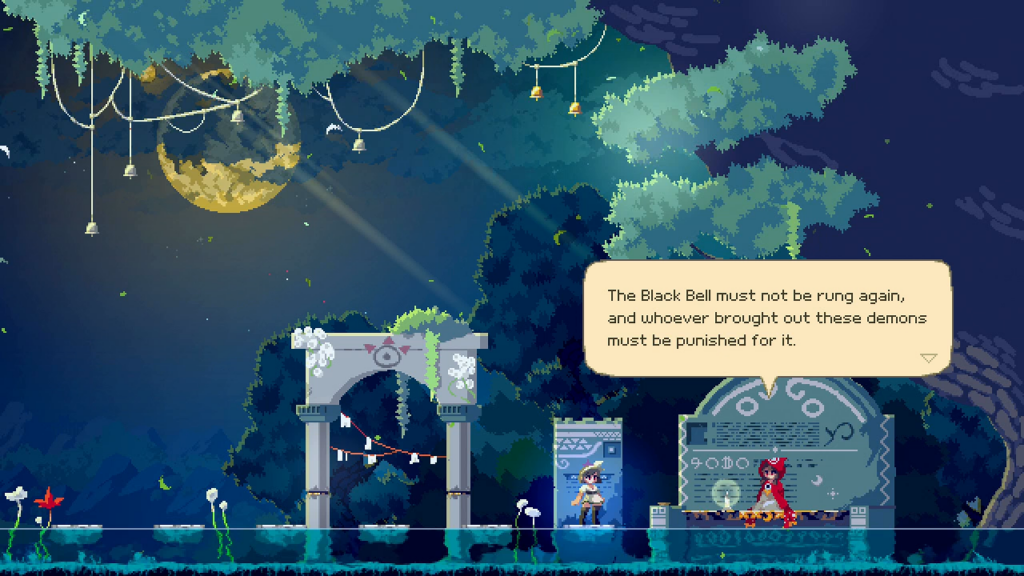
As a non-linear platformer, Momodora: Moonlit Farewell concentrates on fundamentals. When Momo first leaves Koho Village, her limited platforming skillset restricts the number of obstacles she is able to overcome. These restrictions force her to follow a narrow path through the non-linear environment until she receives her first magical artifact, the Sacred Anemone, which allows her to sprint. Sprinting opens up a few more paths, which leads to another artifact, which opens more paths, and so on until Momo has complete access to the entire world. None of these unlockable abilities are unusual. From the wall jump to the double jump, Momo has studied the principles of her genre and replicated all their abilities for her own adventure.
The limited number of platforming abilities necessarily limits the scale of the world. Excluding the two friendly villages Momo visits, there are seven regions for her to explore. Of these seven, only four are connected to each other in any meaningfully non-linear way. The remaining three areas sit on the edges of the world map with single points of entry. The result is a simple and compact open-ended world that is more concerned with keeping me on the path to Momo’s next major goal than in getting me lost in an arcane labyrinth.
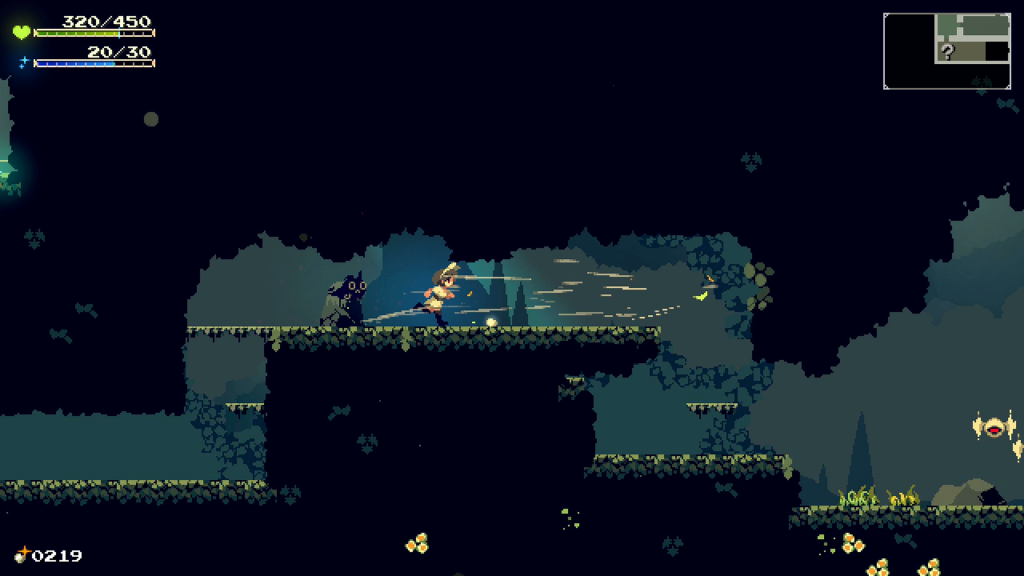
This world features strong contrasts between dark and light. Since Koho Village worships a moon goddess, this is likely intentional. The squares of earth that represent the world’s walls and platforms are drawn in dark shades of green or blue, or most frequently, pure black. Their edges are decorated with simple textures to make them blend in with the spaces Momo can actually explore and interact with.
I can quickly place Momo’s location in the world by looking at the objects and colors that surround her. Knee-length grasses in gentle greens typify the Springleaf Path, the first area Momo explores. These give way to the wilder areas of the Lun Tree Roots, where unkempt brown grass, shrubs, and short trees dominate. The Demon Frontier found deep beneath the world has lots of red, though it’s difficult to tell as this is where the lighting is at its most dynamic. Far from the light of the moon that Koho Village worships, this demon-blighted deepscape is strangled by shadows broken only by Momo’s supernatural inner light and the bioluminescent plants and rocks that glow an eerie blood red.
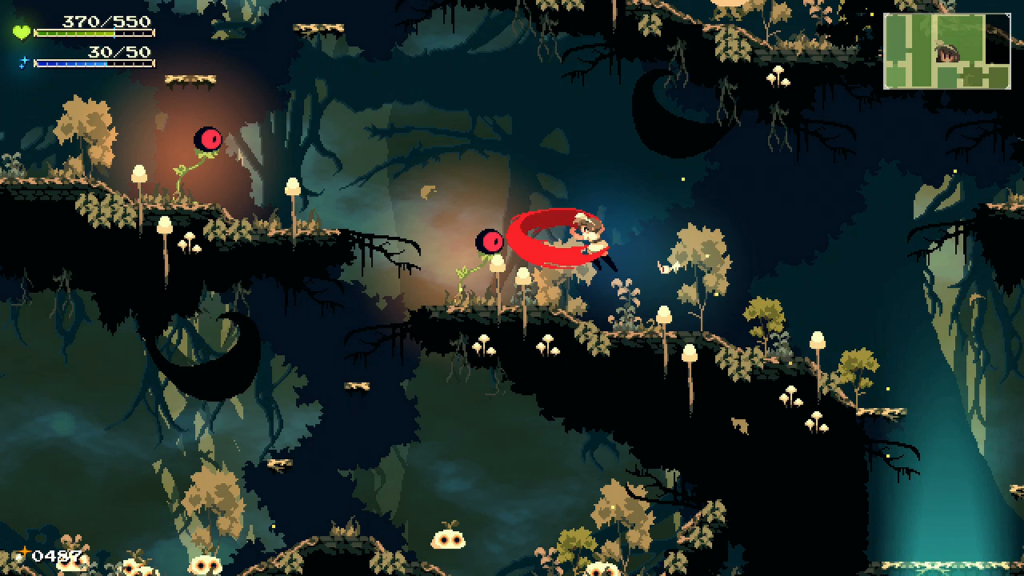
Many of the decorative objects in every region are repeated multiple times even across the same room, but they are intricate enough that they don’t stand out too much. Only the giant seashells embedded in the Fairy Spring’s sandy floors give the impression of being indiscriminately copy and pasted.
In the days of classic non-linear platforming, it was a truism that the player character’s exploration of the world was an expression of their power. The greater their map completion percentage, the more collectables they would have found, which meant the player character had a higher hit point total, more resources, and better, rarer weapons. As non-linear platforming design has drifted more into the realm of stat-based roleplaying and story-driven adventure videogames, this has become less of a given. Momodora: Moonlit Farewell is a refreshing return to tradition.
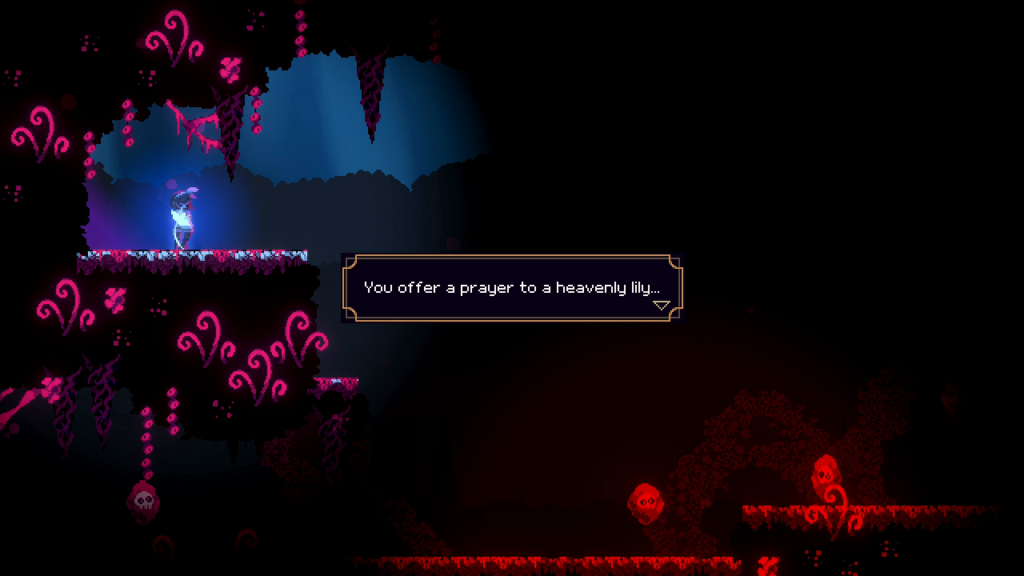
The world Momo explores is strewn with collectables and every one of them improves her attributes in some way. The most important are differently colored and patterned berries that improve her health, magic, and stamina meters, and lily flowers that increase her attack power when she prays in front of them. These powerups connect Momo’s strength and resilience to the amount of the map she has explored in a way that feels like an extension to the foundational non-linear platformers of the 1990s.
Momodora: Moonlit Farewell isn’t without some embellishments that feel more contemporary. Trapped Lumen Fairies ignore Momo when freed from their golden cocoons, but she may be rewarded if she rescues enough of them—provided she can also find the stranger who gathers them. Companion familiars attack enemies or periodically shower Momo with gems that regenerate her health or magic. A collection of sigils provide dramatic improvements to some of Momo’s statistics but she is limited in the number she may equip. The loadout I choose for her determines whether she is a fierce combatant, an impenetrable barrier, a tenacious healer, or even a frail mortal who dies in one hit if I feel like a challenge.
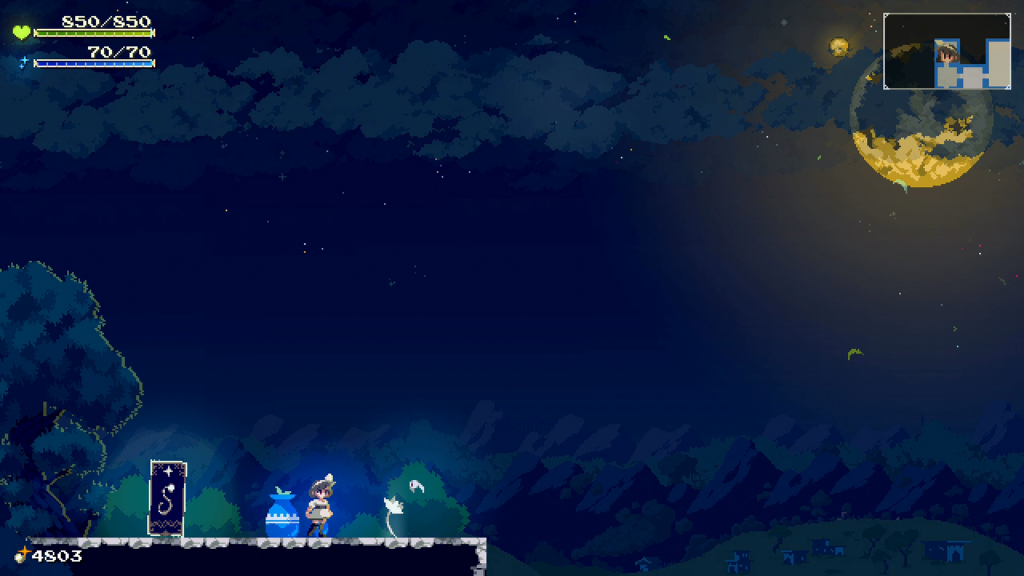
Momo might find herself in a difficult spot if too many of these collectables were difficult to find. Luckily for her, finding them is made simple by the map. If one or more collectables in a square remains unclaimed, the appropriate room on Momo’s map is automatically labeled with a question mark. There are no breakable walls or cryptic puzzles blocking her access to collectables. The greatest obstacle are tunnels hidden in the scenery which only reveal themselves when Momo steps through an apparently solid wall. Ensuring the player character is always at her maximum potential for her next major encounter requires little more than effort, frequent consultation of her map, and legwork.
As Momo explores, she encounters a number of non-player characters. Momo’s assistant priestess Cereza is the most common sight. I am meant to believe that Cereza is having her own adventure parallel to Momo, though this idea is undermined by Cereza’s only appearing near save points. Momo can share meals with her assistant at different milestones and I earn an achievement when the pair reach “maximum friendship.” I sense no impact on the narrative from any of these ideas. Cereza feels more like a Sigil vendor than a significant character in Momo’s quest.
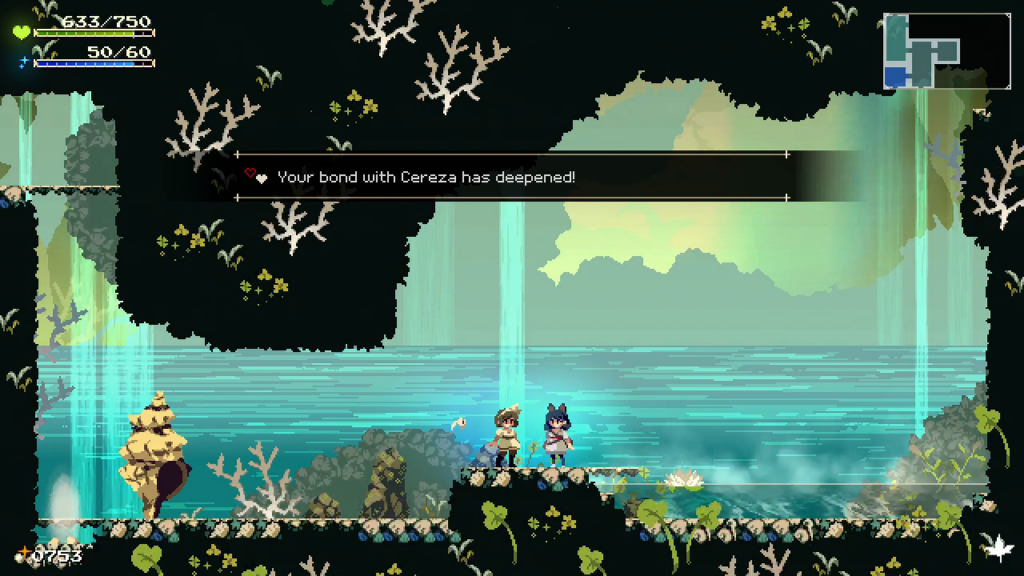
The idea of a contrasting character having their own adventure is executed much more successfully with Isadora “Dora” Doralina, another Koho Village moon priestess who conducts her own investigation into the disappearance of The Black Bell. She appears at multiple points throughout the story, even helping Momo out during a boss fight or two. Momo also runs into Melilot, an archeologist from a kingdom named Karst, who studies the ruins found around the Lun Tree. She is like a mobile exposition unit, her studies of artifacts and engraced texts hinting at a greater conflict between two sibling gods without requiring Momo to travel back to Koho Village to hear it.
Dora and Melilot both hint at the much larger universe portrayed in the previous Momodora videogames, which I have not had the privilege of playing. This lack of experience did not leave me feeling lost in Moonlit Farewell’s characters and events. It communicates just enough information about its world and the people within it to be comprehensible as a self-contained narrative while also carrying on those ongoing plotlines.
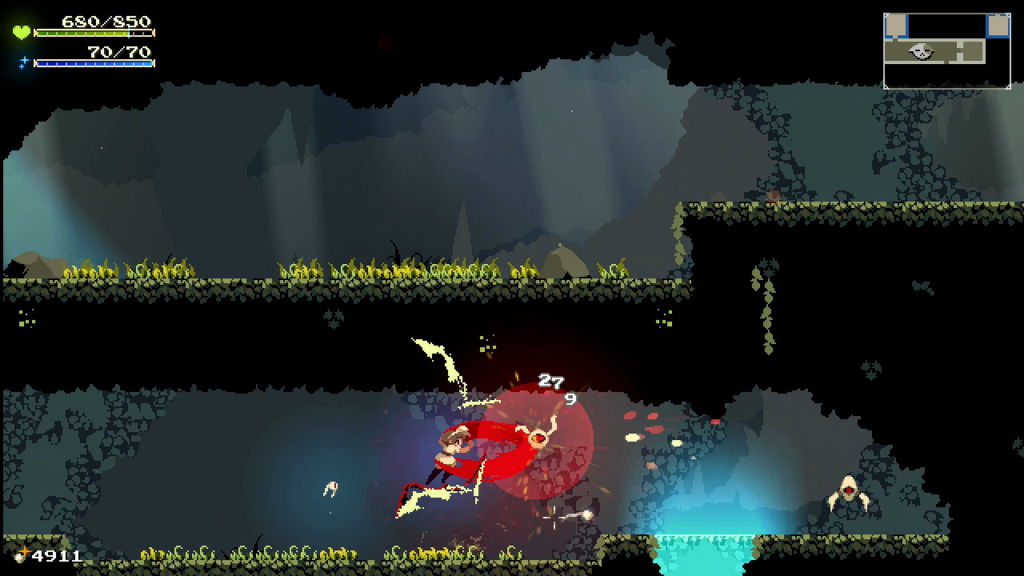
Combat is typically fast and requires good reaction time to telegraphed enemy attacks. Momo uses an enchanted leaf in combat that she swings in a short, three-step combo. The third step unleashes a whirlwind that deals the majority of the combo’s damage, encouraging Momo to reach for this step as often as possible. She may further modify her attacks using Sigil cards, including one set that adds magical swords to all three steps of her combo. Momo’s other offensive option is a bow and arrow. It attacks more slowly and deals less damage than the leaf, but may be fired near-endlessly from the safety of a screen away.
The demons and other malevolent creatures Momo faces are notable for their simplicity. Many have only one or two attacks which they repeat endlessly, lacking surprise counters or punishments for standard evasion tactics. This includes most of the bosses. Once I learn to guide Momo away from attacks, her enemies become easy to dispatch. Her primary tool for evasion is a short dodge roll. It is limited by a stamina meter that is quickly drained by repeated use of the dodge roll. Enemy attack variety is so minimal that this limiting feels nominal. Not once in my playtime does Momo get caught up in an enemy attack because of a drained stamina meter.
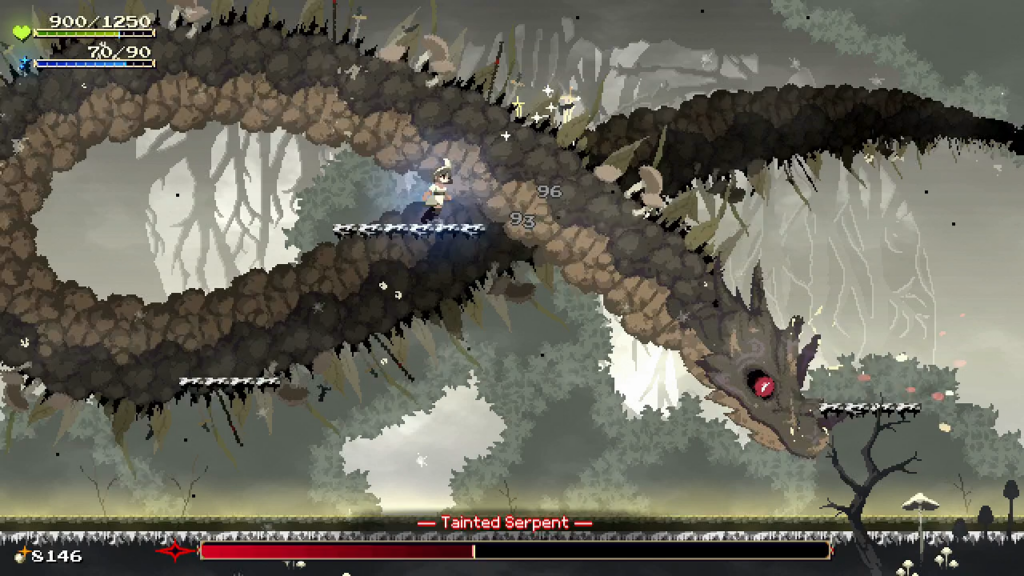
When Momo does take damage, she may heal it in an instant by ringing a magical bell. This does take a portion of her magic meter, but it has so few uses outside of the healing bell that it essentially acts as her healing meter. The bell may be used at almost any time, even in midair or while Momo is under sustained attack, making it easy to top off her health even in the most dire circumstances. Many of the rewards Momo receives from NPCs for helping them with their problems further empowers the bell, increasing its healing capabilities and even damaging enemies near her when she uses it. Diligently explore the world transforms the bell from a useful tool to one that minimizes any danger Momo may encounter.
All of this means that Momodora: Moonlit Farewell is not a challenging videogame, especially if I take the time to collect all of Momo’s upgrades and alter her attacks with powerful Sigils.
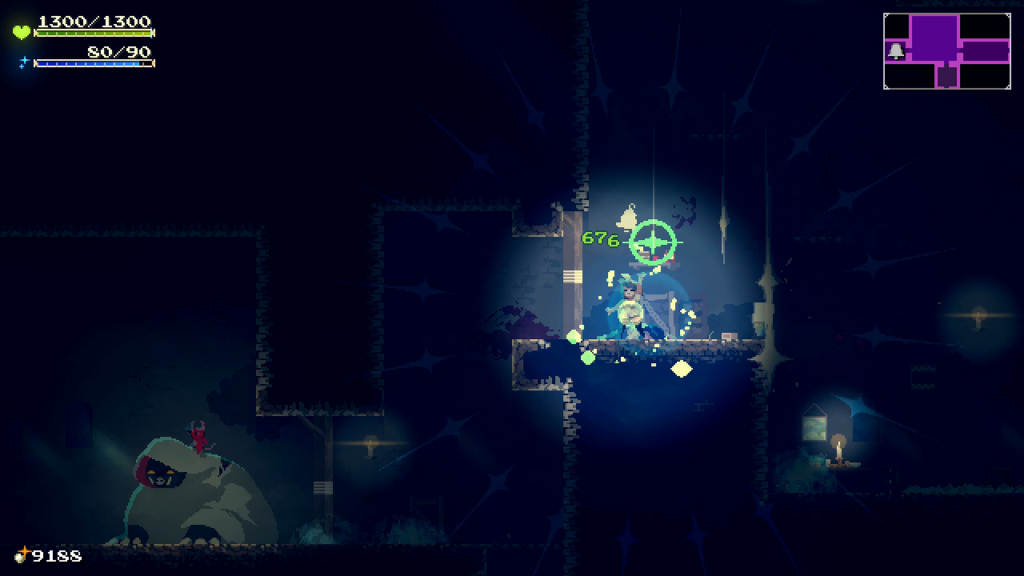
Most of my difficulty comes, not from actual combat design, but from poor visual feedback. When Momo takes damage or her health reaches a critical level, it’s often difficult to recognize through the haze of visual effects overwhelming the screen and cacophony of sound effects drowning out her cries. Most of her deaths occur before I have a chance to realize she’s almost dead. I learn to consciously restrain Momo in combat to prevent this from happening, to take the occasional break from her attack combo to make sure she is not in danger.
This is not to suggest that Momodora: Moonlit Farewell is a pushover. There is a notable bump in difficulty as Momo reaches the doorstep to the big bad’s fortress. Bosses from this point forward have much more intricate design and deal much more damage when their attacks connect. This shift is abrupt and disconcerting when it first appears. When I consider it in hindsight, it keeps me from thinking of this videogame as a total pushover. It’s a welcome shift.
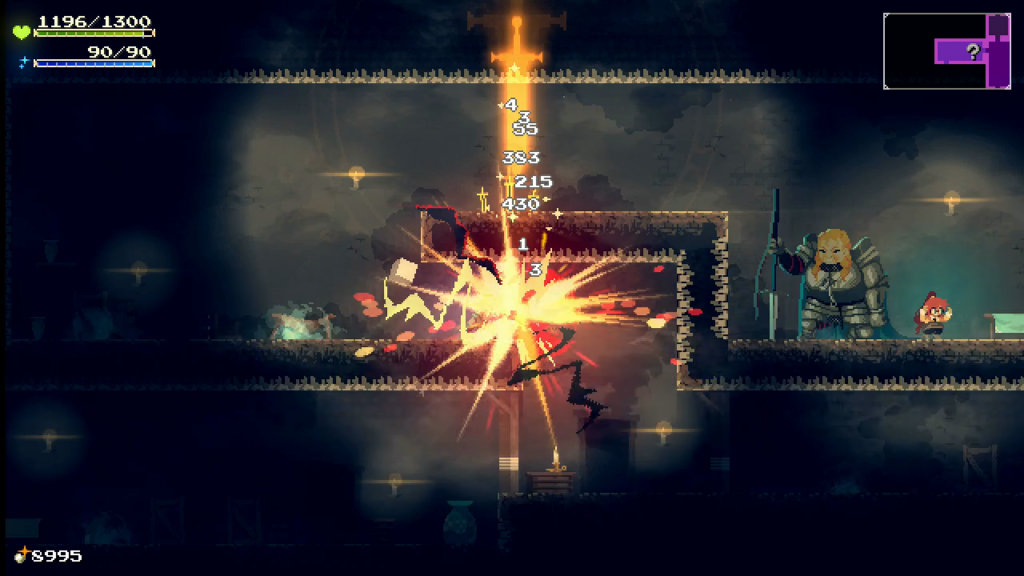
The difficulty continues to skyrocket after the credits have rolled and Momo is presented with the traditional optional, postgame challenges. After returning to Koho Village, Momo is invited by a towering woman with blue skin to The Last Layer, a starscape with platforms seemingly made of light where she may rechallenge every boss she has vanquished. Every boss receives a flat upgrade to match the final boss, so Momo may not curbstomp the first boss in two or three hits using her boosted attack power. Each boss also receives a new Nightmare form that transforms them into a new and much more challenging battle.
Beating Momo’s default campaign also unlocks Arrange Mode. At first, the only noticeable difference to this new campaign is a mirrored world. The more I play, the more I start to recognize other, more subtle differences that make for a much more difficult campaign. If I’m looking for a challenge from this videogame, it really makes me dig for it.
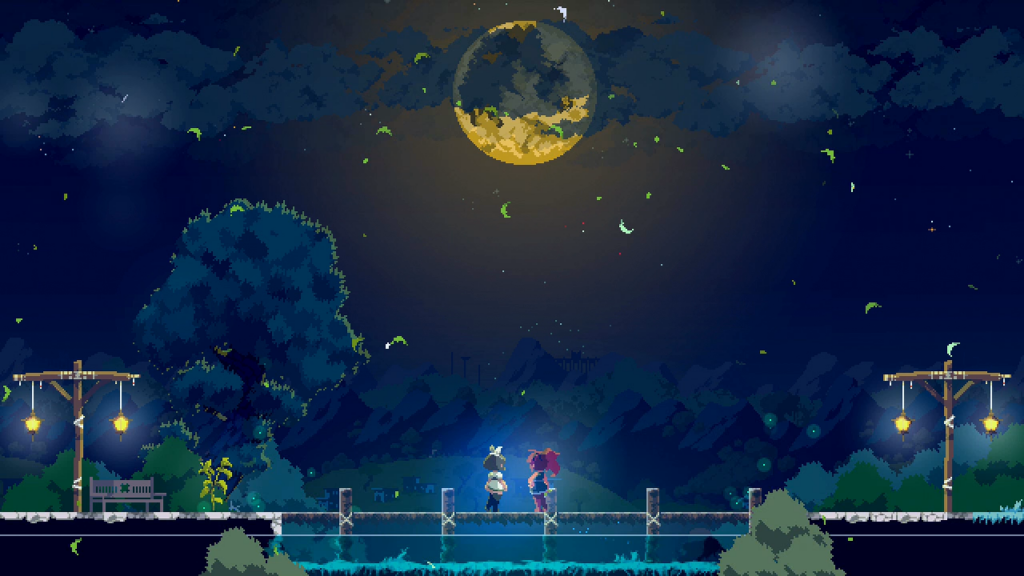
Momodora: Moonlit Farewell revels in embodying non-linear platforming fundamentals. It is not groundbreaking in any way, and in an environment where every other determined protagonist with a vast side-scrolling world to explore is looking for some gimmick to make it unique among the pack, that is what makes Momo special. When I catch myself wishing its world was larger, I remember that its scale is necessitated by its back-to-basics approach. I comfortably finish Momo’s adventure in under ten hours, including finding every collectable, because that’s how long it would take complete an adventure with Samus. If I have a real complaint, it’s the difficulty curve, which is practically a flat line before curving sharply upwards just before the final boss. The new activities introduced post-credits spike the difficulty higher and higher. Momodora: Moonlit Farewell is a great choice for non-linear platforming fans looking to reacquaint themselves with what makes their favorite genre great.